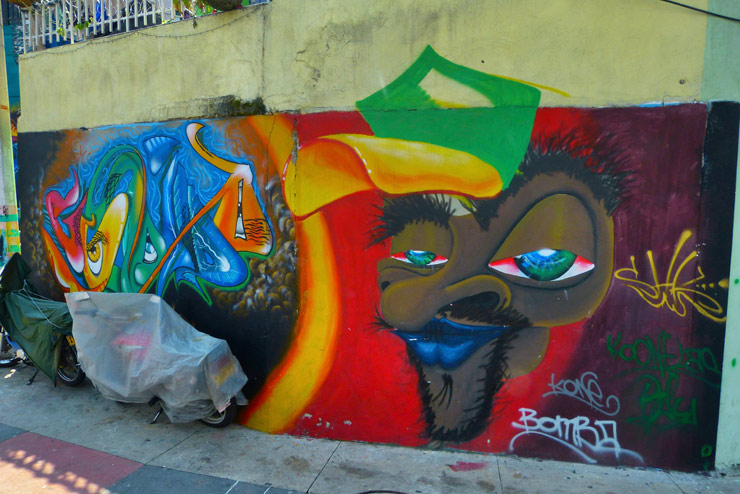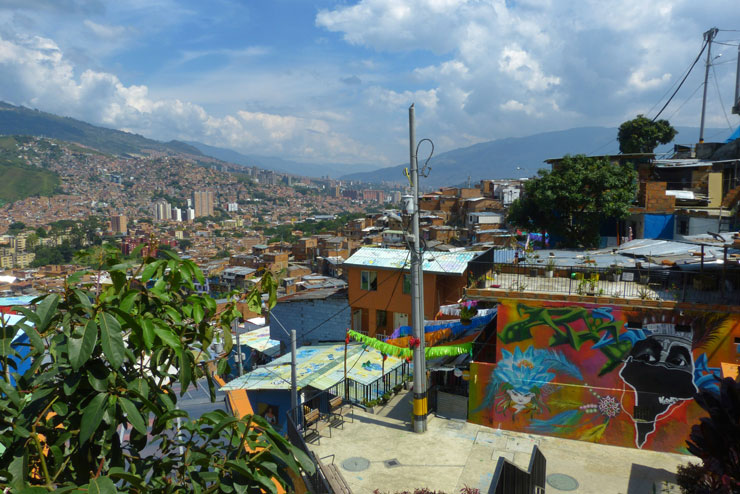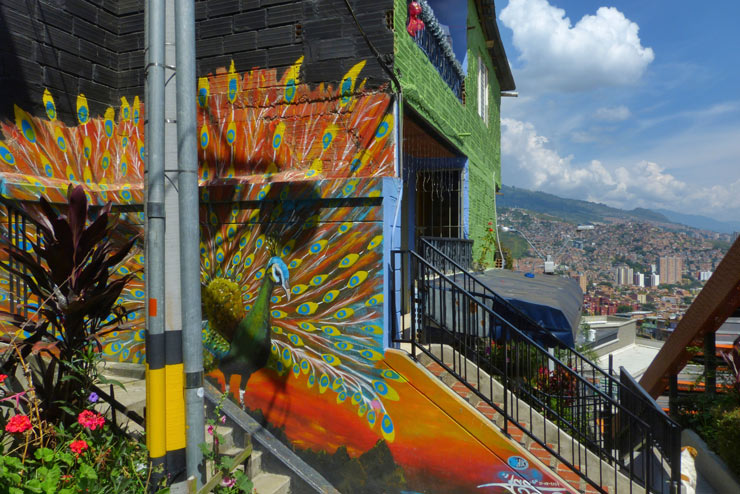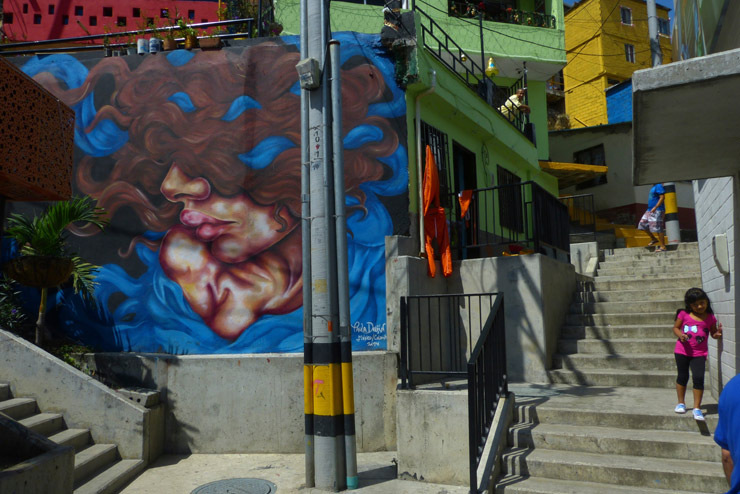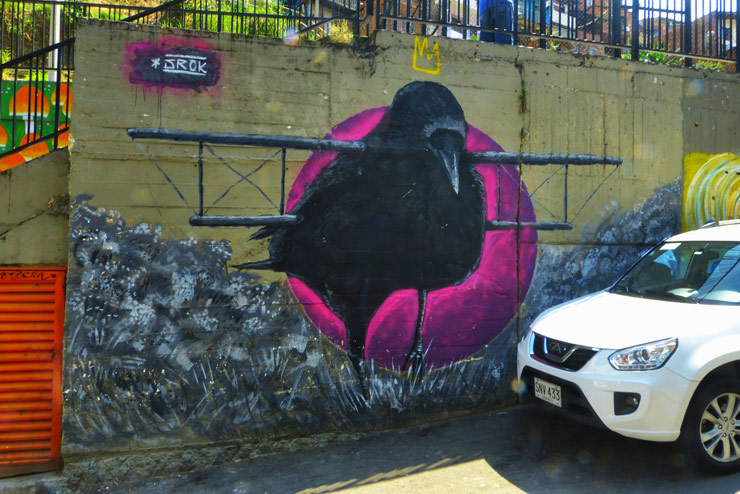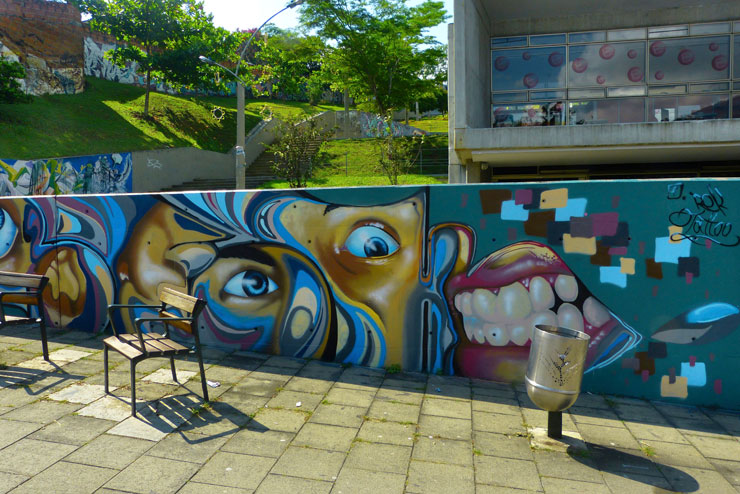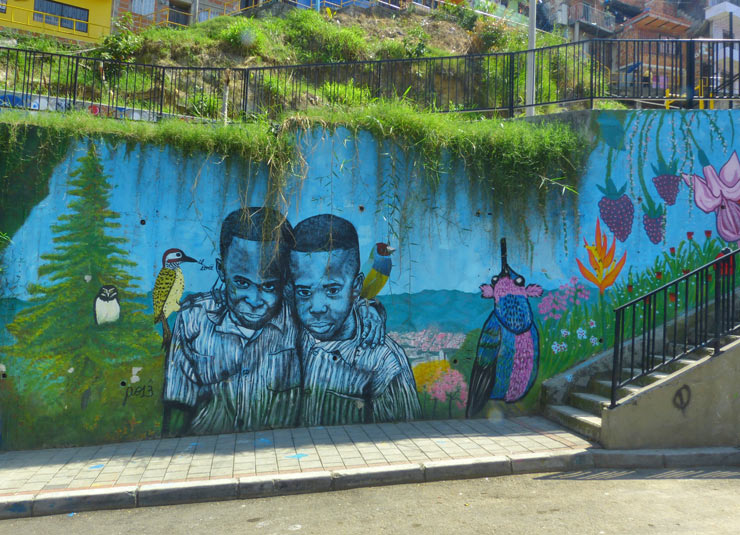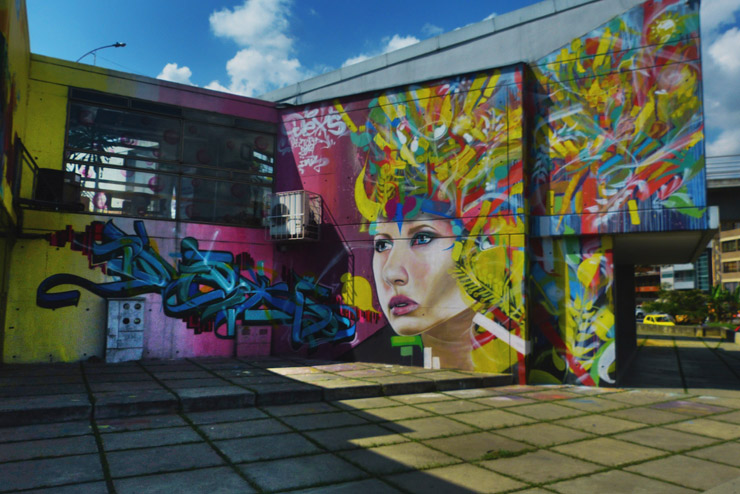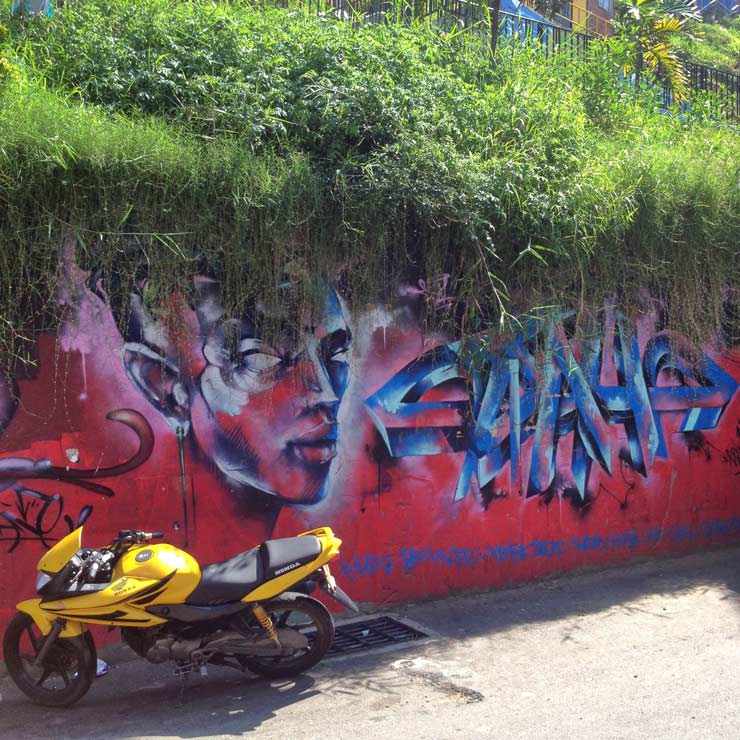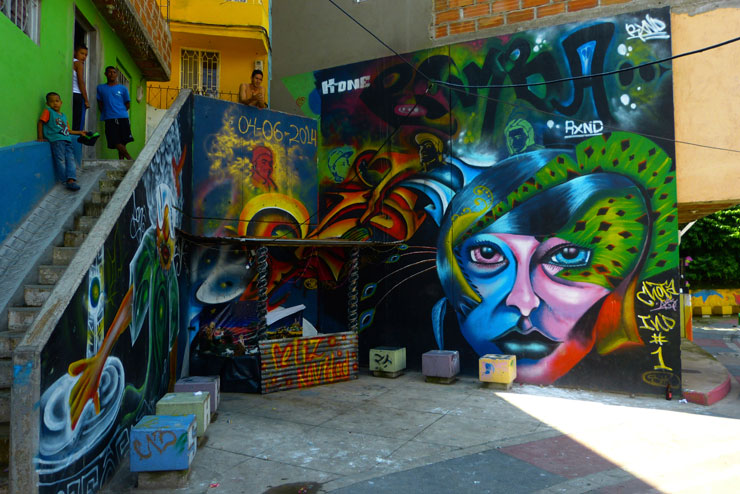San Javier, aka “Comuna 13”, is considered the most dangerous, crime-ridden district in Medellín, the second largest city in Colombia. It has been plagued by violence at the hands of drug cartels, local gangs, guerillas and paramilitary groups all of whom seek control of its strategic location as a crossroads of illegal goods coming into and out of Medellín, and thus Colombia as a whole. In 2010, the neighborhood saw 162 murders for every 100,000 people, an astonishing 10 percent of all homicides in the city.
Comuna 13. Medellin, Colombia. (photo © Yoav Litvin)
Traveling through Medellín, I was intrigued to hear from a local art lover of a street art and graffiti project at Comuna 13 aimed at bringing art, education and peace to this embattled community. Using art as an instrument for the promotion of peace has a bloody history in Comuna 13, where 10 hip-hop artists were murdered as they tried to endorse an end to violence.
Determined to see the project for myself, I sought a local guide who would agree to take me there. I was surprised to discover that there was a company that organizes tours of Comuna 13 and the next morning at 10 a.m. I met Juan Manuel, a friendly local resident who is bilingual and co-founder of “Discover Medellín”.
For a couple of hours we walked together through the streets of Comuna 13, taking in all the beautiful art that is part of the “Medellín is painted for life” project. Throughout the tour the very knowledgeable Juan educated me on the local government’s efforts to revitalize the community at San Javier, including the installation of an escalator system aimed at helping residents get to and from work, free house paint for residents in a variety of colors and investment in the construction of nearby libraries that would cater to the communities largely younger population, steering them away from crime. According to Juan, these investments have led to a dramatic reduction in violence and a transformation of Comuna 13.
Chota. Medellin, Colombia. (photo © Yoav Litvin)
I had the opportunity to ask Juan Manuel about these changes at Comuna 13 with a focus on the role of street art:
YL: What is the role of art in Comuna 13?
JM: Art serves multiple purposes. It allows local artists to share their passion for art with the local community. It’s a positive influence for younger troubled kids who have limited opportunities in Colombia. Many are discriminated against solely because of the notorious barrio they live in. The public art also serves as a historical record with many of the murals documenting Medellín’s violent past. Recently, several home-owners along the tour have approached me with an invitation to paint a mural on their walls to help improve the reputation of their community.
YL: How has the government promoted the art and artists in Medellín?
JM: The local government has been actively involved in the recruitment of artists to paint murals in Comuna 13 as well as various other locations across the city. The legal walls have been a big hit with local artists who are eager to create and share their passion with the rest of the city. The local government continues to actively search for new areas throughout the city for displaying public art. In addition, the local government has sponsored artists by providing them with the monetary funds to complete various projects throughout the city.
YL: What is the role of art in Comuna 13?
JM: Art serves multiple purposes. It allows local artists to share their passion for art with the local community. It’s a positive influence for younger troubled kids who have limited opportunities in Colombia. Many are discriminated against solely because of the notorious barrio they live in. The public art also serves as a historical record with many of the murals documenting Medellín’s violent past. Recently, several home-owners along the tour have approached me with an invitation to paint a mural on their walls to help improve the reputation of their community.
YL: How has the government promoted the art and artists in Medellín?
JM: The local government has been actively involved in the recruitment of artists to paint murals in Comuna 13 as well as various other locations across the city. The legal walls have been a big hit with local artists who are eager to create and share their passion with the rest of the city. The local government continues to actively search for new areas throughout the city for displaying public art. In addition, the local government has sponsored artists by providing them with the monetary funds to complete various projects throughout the city.
JM: The local government has been actively involved in the recruitment of artists to paint murals in Comuna 13 as well as various other locations across the city. The legal walls have been a big hit with local artists who are eager to create and share their passion with the rest of the city. The local government continues to actively search for new areas throughout the city for displaying public art. In addition, the local government has sponsored artists by providing them with the monetary funds to complete various projects throughout the city.
Artist Unknon. Medellin, Colombia. (photo © Yoav Litvin)
YL: Do you believe the art has a positive role in affecting crime levels in Medellín? How?
JM: Yes. Walking tours like this would not be possible without the drastic changes in the community. A few years ago, violence was a daily occurrence in the community. But after the local government invested millions of dollars in paint for local residents and allowed local artists to paint murals throughout Comuna 13, safety in the area has greatly improved. These acts have given many long-term residents faith in local politicians who risked political backlash. Locals now see more and more interest in their community from the government, businesses, residents from other parts of Medellín and a few foreigners like you who are eager to explore the transformation of Comuna 13.
YL: What are your plans for the future?
JM: Together with my partner Arthur, we are currently in the process of securing funding for an art project in Comuna 13. The goal is to invite artists from around the world to paint inspirational art projects aimed at promoting the community.
JM: Together with my partner Arthur, we are currently in the process of securing funding for an art project in Comuna 13. The goal is to invite artists from around the world to paint inspirational art projects aimed at promoting the community.
Paola Delfin. Medellin, Colombia. (photo © Yoav Litvin)
After our tour I returned to my hostel and told my hostess of my experience. She was horrified to learn that I visited Comuna 13 and told me that the only reason I was left unharmed was because I had the obvious look of a foreigner: “Me and my friends never go there. If you look local or Latino in general, you are stopped, questioned, or worse… They are always suspicious of young men who may be from a rival gang.” she said.
Most of the street art and graffiti in Comuna 13 was made by kids or young people that received graffiti classes in Casa Kolacho or Casa Morada, by social entities which work with young people in some parts of this big infamously violent community.
Senor OK . Grena Cru. Medellin, Colombia. (photo © Yoav Litvin)
REK. Medellin, Colombia. (photo © Yoav Litvin)
Bomba . Kone. Medellin, Colombia. (photo © Yoav Litvin)
El Pole. Medellin, Colombia. (photo © Yoav Litvin)
DEXS. Medellin, Colombia. (photo © Yoav Litvin)
Javid Jah. Medellin, Colombia. (photo © Yoav Litvin)
Kone . AXND. Medellin, Colombia. (photo © Yoav Litvin)
Our thanks to Yoav for his contribution and for sharing his trip and observations with BSA readers.
<<>>><><<>BSA<<>>><<<>><><BSA<<>>><><<>BSA<<>>><<<>><><BSA Please note: All content including images and text are © BrooklynStreetArt.com, unless otherwise noted. We like sharing BSA content for non-commercial purposes as long as you credit the photographer(s) and BSA, include a link to the original article URL and do not remove the photographer’s name from the .jpg file. Otherwise, please refrain from re-posting. Thanks! <<>>><><<>BSA<<>>><<<>><><BSA<<>>><><<>BSA<<>>><<<>><><BSA
Other Articles You May Like from BSA:
Thanks to a globalism of culture, many cities around the world have sprouted vibrant Street Art scenes – including today’s focus, Bogotá, Columbia. Far more open to expression than many cities, Bogotá...
From cave carvings in Angoulême in western France 27,000 years ago to your daily, perhaps hourly selfie on a cell phone today, our desire to depict the figure is as much a reflection of the arti...
Yesterday, we shared with you the current edition of The Crystal Ship, a Belgian street art festival located in Ostend, which is located in the Flemish Region of Belgium. The collection of images tha...
Colombian Street Artist Erre began her career on the street in her home city of Zipaquirá as a teen but moved an hour’s drive south to the capital city Bogotá a few years ago to attend university an...
Édgar Sánchez and Arcadi Poch may not simply be curators of the new initiative called Mexpania that merges the cultures of Mexico and Spain. They are social scientists, anthropologists, historians, a...
 BROOKLYN STREET ART LOVES YOU MORE EVERY DAY
BROOKLYN STREET ART LOVES YOU MORE EVERY DAY